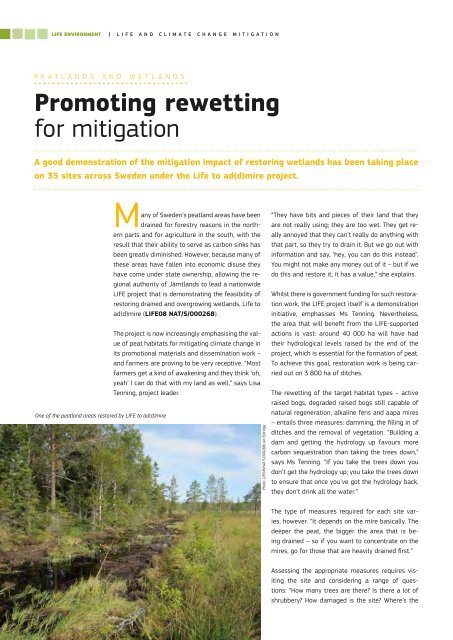You also want an ePaper? Increase the reach of your titles
YUMPU automatically turns print PDFs into web optimized ePapers that Google loves.
LIFE ENVIRONMENT |LIFE and Climate CHANGE mitigationpeatlands and wetlandsPromoting rewettingfor mitigationA good demonstration of the mitigation impact of restoring wetlands has been taking placeon 35 sites across Sweden under the Life to ad(d)mire project.One of the peatland areas restored by LIFE to ad(d)mireMany of Sweden’s peatland areas have beendrained for forestry reasons in the northernparts and for agriculture in the south, with theresult that their ability to serve as carbon sinks hasbeen greatly diminished. However, because many ofthese areas have fallen into economic disuse theyhave come under state ownership, allowing the regionalauthority of Jämtlands to lead a nationwideLIFE project that is demonstrating the feasibility ofrestoring drained and overgrowing wetlands, Life toad(d)mire (LIFE08 NAT/S/000268).The project is now increasingly emphasising the valueof peat habitats for mitigating climate change inits promotional materials and dissemination work –and farmers are proving to be very receptive. “Mostfarmers get a kind of awakening and they think ‘oh,yeah’ I can do that with my land as well,” says LisaTenning, project leader.Photo: LIFE08/NAT/S/000268/Jon Eldridge“They have bits and pieces of their land that theyare not really using; they are too wet. They get reallyannoyed that they can’t really do anything withthat part, so they try to drain it. But we go out withinformation and say, ‘hey, you can do this instead’.You might not make any money out of it – but if wedo this and restore it, it has a value,” she explains.Whilst there is government funding for such restorationwork, the LIFE project itself is a demonstrationinitiative, emphasises Ms Tenning. Nevertheless,the area that will benefit from the LIFE-supportedactions is vast: around 40 000 ha will have hadtheir hydrological levels raised by the end of theproject, which is essential for the formation of peat.To achieve this goal, restoration work is being carriedout on 3 800 ha of ditches.The rewetting of the target habitat types – activeraised bogs, degraded raised bogs still capable ofnatural regeneration, alkaline fens and aapa mires– entails three measures: damming, the filling in ofditches and the removal of vegetation. “Building adam and getting the hydrology up favours morecarbon sequestration than taking the trees down,”says Ms Tenning. “If you take the trees down youdon’t get the hydrology up; you take the trees downto ensure that once you’ve got the hydrology back,they don’t drink all the water.”The type of measures required for each site varies,however. “It depends on the mire basically. Thedeeper the peat, the bigger the area that is beingdrained – so if you want to concentrate on themires, go for those that are heavily drained first.”Assessing the appropriate measures requires visitingthe site and considering a range of questions:“How many trees are there? Is there a lot ofshrubbery? How damaged is the site? Where’s the74


